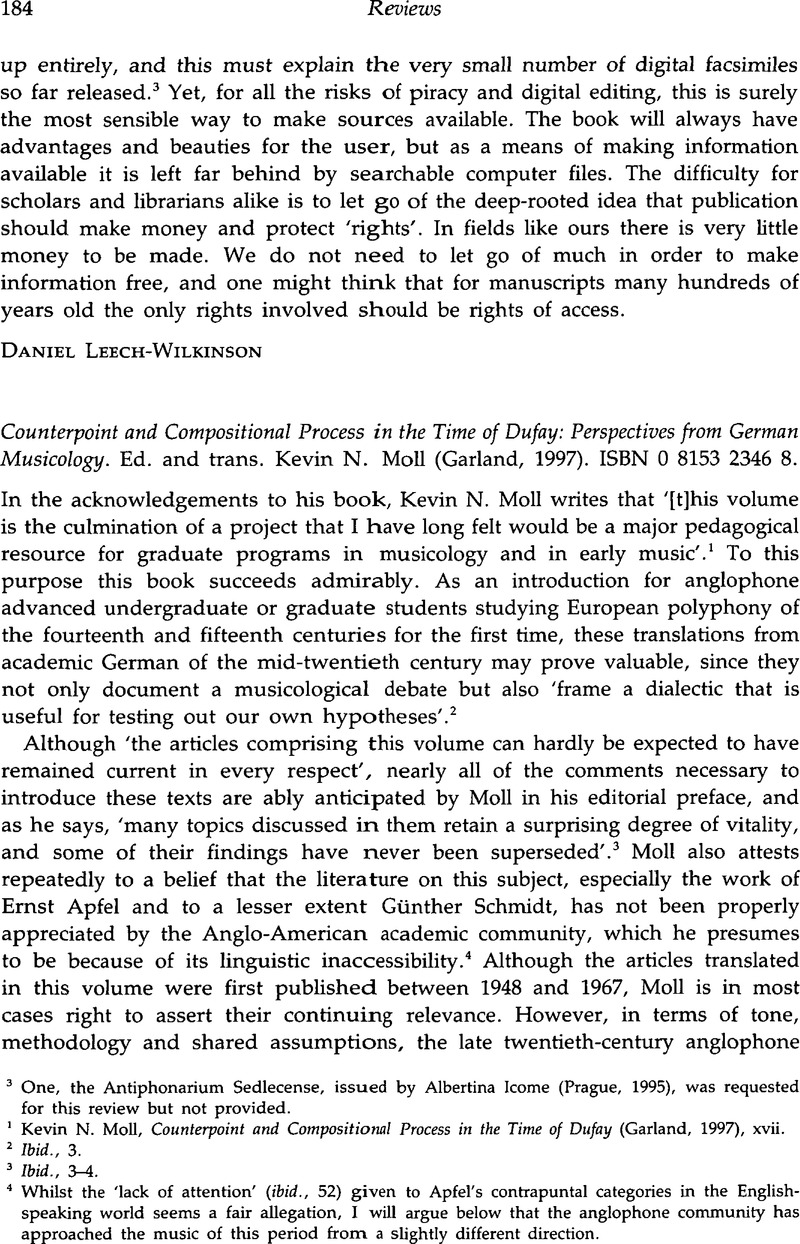No CrossRef data available.
Published online by Cambridge University Press: 12 September 2008

3 One, the Antiphonarium Sedlecense, issued by Albertina Icome (Prague, 1995), was requested for this review but not provided.
1 Moll, Kevin N., Counterpoint and Compositional Process in the Time of Dufay (Garland, 1997), xvii.Google Scholar
2 Ibid, 3.
3 Ibid, 3–4.
4 Whilst the ‘lack of attention’ (Ibid, 52) given to Apfel's contrapuntal categories in the Englishspeaking world seems a fair allegation, I will argue below that the anglophone community has approached the music of this period from a slightly different direction.
5 Besseler's ‘Dufay - Creator of Fauxbourdon’ (1948), von Ficker's ‘Toward a History of the Genesis of Fauxbourdon’ (1951), and Besseler's ‘Tonal Harmony and Full Sonority: A Reply to Rudolf von Ficker’ (1952) translated in Moll, 65–148.
6 Ibid, 5.
7 Ibid, 5.
8 For example, Besseler is translated as saying that: ‘Precisely in this time of transition, which must lie shortly before 1431, falls the boundary betweenthe corpus and the secondary entries in BL. Three smaller motets of Dufay and several sectionsof his Sancti Jacobi Mass display already in the corpus the new tempus perfectum diminutum’ (p.70). Without needing re-translation from the original, this could be rendered more idiomaticallyas: The boundary between the [main] corpus and the secondary entries in BL falls precisely inthis time of transition, which must lie shortly before 1431. In the [main] corpus three smaller motets by Dufay and several sections of his Sancti Jacobi Mass already display the new tempus perfectum diminutum’.
9 Moll, Kevin N., ‘Structural Determinants in Polyphony for the Mass Ordinary from French and Related Sources (ca. 1320–1410)’ Ph.D. diss., Stanford University (1994), 68–94.Google Scholar
10 Wolfgang Marggraf, ‘Tonality and Harmony in the French Chanson between Machaut and Dufay’ (1966) and Ernest H. Sanders, ‘The Effect of Medieval English Polyphony upon the Development of Continental Cantus-Firmus Techniques and Tonal Structure’ (1967), translated in Moll 1997,301–62.
11 Bernhard Meier, ‘Harmony in the Cantus-Firmus Compositions of the Fifteenth Century’ (1952), Ernst Apfel, The “Tonal Discant” and “Free Discant” Techniques of Composition in the Fifteenth Century’ (1955), Günther Schmidt, ‘The Cantus-Firmus Question in the Fourteenth and Early Fifteenth Centuries’ (1958), Ernst Apfel, ‘The Origin of True Four-Voice Counterpoint in England’(1960), Ernst Apfel, ‘Four-Voice Counterpoint in the Fourteenth and Fifteenth Centuries’ (1961), Ernst Apfel, ‘The Harmonic Structure of Late Medieval Music as a Foundation of Major-MinorTonality’ (1962), Ernst Apfel, ‘Late Medieval Harmonic Structure and Major-Minor Tonality’ (1963), translated in Moll 1997, 149–299.
12 Sanders, ‘The Effecf’, translated in Moll 1997, 341.
13 See Moll 1997, 5–11.
14 Ibid, 48.
15 Ibid, 45.
16 Ibid, 47.
17 Ibid.
18 Ibid., 52.
19 Moll 1994.
20 Quoted in Ibid 196, n. 17.
21 Moll 1997, 59.
22 Both points have recently been made more extensively by Bent, Margaret in ‘The Grammar of Early Music: Preconditions for Analysis’ in Collins Judd, Cristle, ed., Tonal Structure in Early Music(New York, 1998). The latter point is discussed in Moll 1994, 184–5.Google Scholar
23 Moll 1997, xi.
24 Ibid, xii.
25 I do not mean to suggest that the access to other art forms is unproblematic but merely that the nature of the problem has not to do with the relation of the trace and the object (but may bein relation to the object and its former state, nature or use).
26 See Bent, Margaret, ‘Musica Recta and Musica Ficta’, Musica Disciplina, 26 (1972), 73–100Google Scholar, ‘Diatonic Ficta’, Early Music History, 4 (1984), 1–18, ‘Diatonic ficta Revisited: Josquin's Ave Maria in Context’, Music Theory Online (mto. 96.2.6.bent.tlk), and especially, ‘Editing Early Music: the Dilemma of Translation’, Early Music, 22/3 (August 1994), 373–94.
27 The exact relationship between theory and practice is another element of disagreement between the two groups of authors in Moll's collection. On one hand, there are those (such as Apfel)who in interpreting the music in line with theory seek to show a conformity, whilst on the otherhand are those (such as Marggraf and Sanders) who assert that theory no longer adequately explains all of the musical features because it is lagging behind practice by this time. The latter group, seeing the former as unnecessarily pedantic and engaged in a self-fulfilling search, thus appeals to the evidence of musical works (although again as if access to them was unproblematic).
28 See, for example, the pair of articles examining Machau's motet 15, Brownlee, Kevin, ‘Machaut's Motet 15 and the Roman de la Rose: The Literary Context of Amours aui a le pouoir/Faus Semblant m'a deceü/Vidi Dominutri’, Early Music History, 10 (1991), 1–14Google Scholar, and Bent, Margaret, ‘Deception, Exegesis and Sounding Number in Machauf's Motet 15’, Early Music History, 10 (1991), 15–27.Google Scholar
29 Moll 1997, xii.